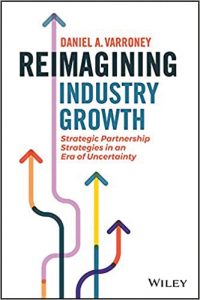
On April 12, 1961, Soviet Cosmonaut Yuri Gagarin became the first human in space. One month later, Astronaut Alan Shephard’s Freedom 7 space capsule sat atop a Mercury-Redstone Rocket awaiting launch at Cape Canaveral, Florida. Technical problems caused flight delays and at some point Shephard grew impatient, extolling, “Why don’t you fix your little problem and light this candle?” At 9:34 a.m. on May 5, 1961, Shephard declared, “Liftoff, and the clock has started!”
Relationship Supremacy
Today, the country faces threats that include COVID-19, political gridlock, inflation, supply chain disruptions, workforce shortages and disruptive technologies. Pursuing industry growth in an era of chronic certainty is especially challenging. What helps move the needle is trusting, and transparent relationships. People who proactively pursue robust and durable personal relationships — whether in business, politics, clubs or on the front porch — tend to be more resilient than others in hard times. Tight-knit communities fare better when threatened than individuals. Having the ability to harness vibrant communities is one of the keys to success in any arena.
Harnessing Relationships through Strategic Partnerships
The most fertile ground for nurturing strategic partnerships within any given industry is through trade associations. That assertion should be obvious to all industry leaders, but if widespread adoption is a fair indicator, the results are not there. It might be that people do not in fact see it or recognize the significant potential of the industry and trade association collaboration. Given the severe nature of today’s challenges, strategic partnerships may seem too hard; they would rather go it alone or incorporate a mixture of both. Regardless, the opportunity to harness the strength of a vibrant community is there for the asking.
Forward-leaning industries have launched strategic partnerships with their trade associations. For those who have, they provide some spectacular examples of what is possible when customer care and business prowess are combined with a relational mindset.
Now is the right time for a change in the way industries and the trade associations that represent them relate with one another, interact and partner. It is also the time for business executives to be focusing on developing, expanding and solidifying strategic partnerships through the industry and trade associations that were designed for just such a purpose.
In the chaos of turbulent times, a solid partnership is proving to be an effective anchor and, in many cases, a safe harbor. That kind of relationship is the reason trade associations exist in the first place. Better still, partnership is one of the elements of business planning that industries and trade associations can proactively choose and maintain a degree of control over.
Strategic Partnerships Can Change the Game for Industries
The generic term strategic partnership entered the business lexicon many years ago, and much has been written on the subject. Today, business analysts and consultants speak of strategic branding partnerships, strategic supply chain partnerships, strategic research and development partnerships, strategic finance partnerships and strategic human resources partnerships. Successful strategic partnerships have been highly effective in countering the negative forces of market volatility, particularly through the last several decades.
Trade associations can operate as strategic partners with the industries they represent; they can serve as the face of their industries, and they can help entire industries achieve extraordinary growth even in the toughest times. Each strategic partner relationship is powered by data and reflects the values and characteristics of industry leaders. They employ industry-focused strategic and scenario planning, and they utilize key performance metrics to measure success.
Proving Industry Growth: Recreational Boating Industry and National Marine Manufacturers Association
At the start of the pandemic, businesses locked down and, in many cases, struggled to find a pathway to growth. However, one industry utilized a different approach — and it worked. Through an impressive ecosystem constructed by its strategic partner, the National Marine Manufacturers Association, the recreational boating industry leveraged its resources to promote the great outdoors and the boating experience. NMMA’s Discover Boating and the Recreational Boating and Fishing Foundation collaborated and launched a Take Me Fishing promotional campaign. Anxious consumers would learn about opportunities to break free from quarantine and enjoy the great outdoors. The campaign was successful, and it helped the recreational boating industry achieve a 20% year over year (2019 to 2020) increase in revenue.
Unmistakably, the recreational boating industry provided an opportunity for consumers in 2020. Frank Hugelmeyer, NMMA president, celebrated the industry’s success despite the global pandemic, “For the first time in more than a decade, we saw an increase in first-time boat buyers, who helped spur growth of versatile, smaller boats — less than 26 feet — that are often towed to local waterways and provide a variety of boating experiences, from fishing to watersports.” Hugelmeyer was preceded by Thom Dammrich as NMMA’s president. It was Dammrich who led the buildout of the recreational boating ecosystem that helped shape the external environment and position the industry for long-term growth. Frank Hugelmeyer was a strong choice to succeed Dammrich because he had previously directed the GoRVing promotion strategy at the RV Industry Association, which was a smashing success and had increased RV sales dramatically in years prior. Industry analysts in the boating community have commented on interesting facts about boat buying in the first year of the pandemic: More boat orders for future delivery were placed in 2020 than in 2019. Unit sales in 2020 exceeded 300,000 units, a number last reached in 2007 (prior to the global financial crisis), and a number most in the industry felt would never be reached again.
Steve Heese, president of Chris-Craft and NMMA chairperson, joined the group’s board and never looked back. “Industry associations have the unique ability to accomplish what their individual members cannot on their own. For example, they can pool the members’ resources and promote the industry on a national scale, lifting demand for the industry’s products and services,” he notes.
Light this Candle
For executives who do not yet engage with industry trade associations need to recognize they are missing a strategic opportunity at a pivotal moment. The stakes are high, and the opportunities are far greater for those who engage right away. As global and domestic challenges intensify, strategic partner relationships represent an industry’s pathway to reimagine industry growth.
Strategic partnerships between industries and trade associations work. They are something to shout from the highest mountaintops. They are worthy of immediate exploration and, over time, should be implemented or expanded for every industry and trade association.
Yes, every bold action has risks, but they are mitigated through strategic partnerships. Astronaut Alan Shepherd utilized his strategic partnership to challenge flight controllers, contractors and engineers to launch Freedom 7. The partnership was put to the test, the challenges were met, and the partnership succeeded. Industry chief executives also have the opportunity to build strategic partnerships with trade associations. In doing so, they build powerful ecosystems that shape the external environment and, over time, position industries for growth.
In other words, strategic partnerships are similar to a Mercury Redstone Rocket. They, too, await the minute when industry executives and trade associations are in their space capsule and join together and say, “Light this candle.” Together, they will challenge one another, make adjustments and, in the end, proclaim, “Liftoff, and the clock is started.” Then, the industry is on its trajectory to Reimagining Industry Growth.
 Daniel A. Varroney is the author of the groundbreaking new book, Reimagining Industry Growth. He founded Potomac Core, a strategic consulting firm specializing in association transformation and industry focused strategic partnerships. He has built a successful career as an association executive, leading organizations with diverse focus, from manufacturing to high tech to finance and advocacy.
Daniel A. Varroney is the author of the groundbreaking new book, Reimagining Industry Growth. He founded Potomac Core, a strategic consulting firm specializing in association transformation and industry focused strategic partnerships. He has built a successful career as an association executive, leading organizations with diverse focus, from manufacturing to high tech to finance and advocacy.
His deep understanding of policy and regulatory influence on industries has shaped his approach to industry strategic partnerships. He graduated from The Catholic University of America with a bachelor’s degree, and holds a Certificate in Leadership and Team Effectiveness from the Yale School of Management.
















Speak Your Mind
You must be logged in to post a comment.